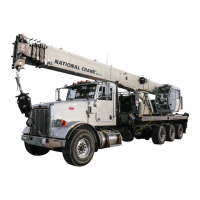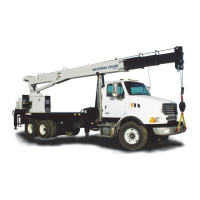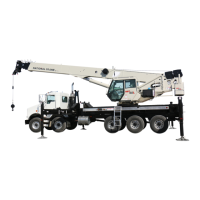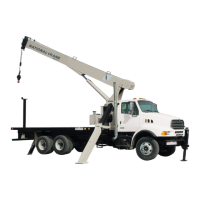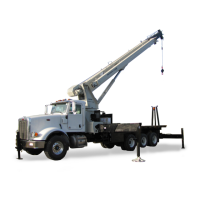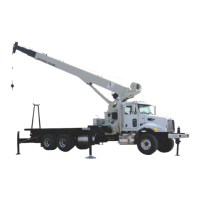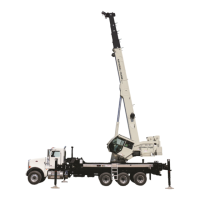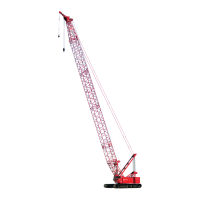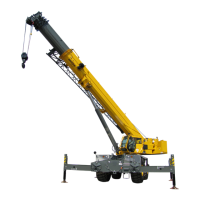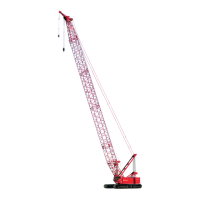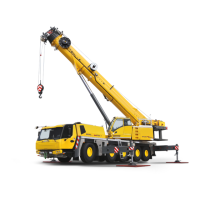National Crane 01-22-2019 Control # 051-08 2-17
1300A HYDRAULIC SYSTEM
Installation
1. Bolt the directional control valve to the enclosure.
2. Reinstall the hydraulic lines as per removal tags.
Functional Check
1. Start the engine and run it at normal speed.
2. Operate the control levers of the valve bank(s). Check
for smooth operation of cylinders and motors.
3. Check the valve bank and lines for leakage. Make
repairs as needed.
RCL Lockout Valves
The purpose of the RCL lockout valves is to disable those
functions which worsen an overload condition. To check the
RCL system, do the following:
1. Remove fuse F9 from the mini fuse panel to disconnect
power to the RCL.
2. Start the engine.
3. Try to telescope the boom out, lower the boom, hoist up.
Verify none of these functions work.
4. Shut down the engine. Reinstall fuse F9.
5. Telescope the boom out, lower the boom, hoist up. Verify
all of these functions work.
6. Check for leaks and repairs as needed.
Hydraulic Remote Controllers
The crane functions are controlled by hydraulic remote
controllers (HRC) on the armrest of the operator’s seat. The
controllers operate from a low pressure pilot circuit which is
generated and controlled by a priority flow divider and relief
valve. Low pressure is applied to the bonnets on each side of
the control valve spools to shift the spool in the required
direction.
Outrigger Manifolds
The outrigger circuits are controlled by two manifolds located
at the front and rear outrigger boxes. The front manifold
contains the extend/retract valve, outrigger enable valve,
outrigger component valves, and the optional single front
outrigger (SFO) valve. The rear outrigger manifold contains
the outrigger component valves for the rear outrigger. The
valves are operated by solenoids that are controlled by
switches on the outrigger control box.
The swing and outrigger functions are on the same hydraulic
circuit however, only one function at a time can be working.
Selection of the function is determined by the outrigger
enable valve which directs the flow to either the swing or
outrigger circuits. When the outrigger control valve is
energized by the extend\retract switch, all flow is directed to
the outrigger circuit. See SECTION 3 for more information on
outrigger manifold solenoids.
Holding Valves
Pilot operated check valves located in the valve block on
each cylinder acts as holding valve to keep the cylinder from
collapse due to hose failure. Do not remove a valve block
unless the cylinder is completely retracted.
Do not try to repair or set the valve pressure. If a holding
valve is suspect, replace it with a new valve.
Swing Gearbox
The standard Glide Swing gearbox is locked in place by an
integrally mounted spring applied disc brake. The swing
brake switch located on the front console and is used to
activate the swing brake and park the turret in position. Press
the switch to activate the swing brake to keep the turret from
rotating. A red LED is illuminated when the swing brake
switch is applied.
The swing control lever can be used to slow and stop the
swing by moving the control lever to the opposite direction of
the swing. For example, if the lever is pushed forward for a
clockwise swing, pull the lever back to slow and stop the
swing.
Crane Function Power Switch
The crane function power switch in the crane cab energizes
a solenoid valve on the crane manifold located in the turret to
activate the controllers in the crane cab. The operator must
be in the operator’s seat for the crane function power switch
to be active.
HYDRAULIC PUMP
Description
The hydraulic system pressure is supplied by a three section
hydraulic gear pump mounted on the truck power take off
(PTO). The hydraulic gear pump requires PTO rating of
189 hp (140.9 kw) at 1800 rpm.
Removal
If pump replacement is required, the hydraulic fluid should
also be replaced because of possible contamination.
1. Drain the hydraulic tank.
2. Tag and disconnect the hydraulic lines from the pump.
3. Remove the bolts from the pump rear mounting bracket.
4. Remove the bolts from the pump mounting flange and
slide the pump out of the PTO drive coupling.
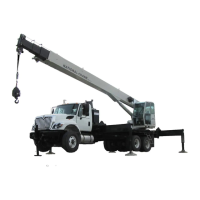
